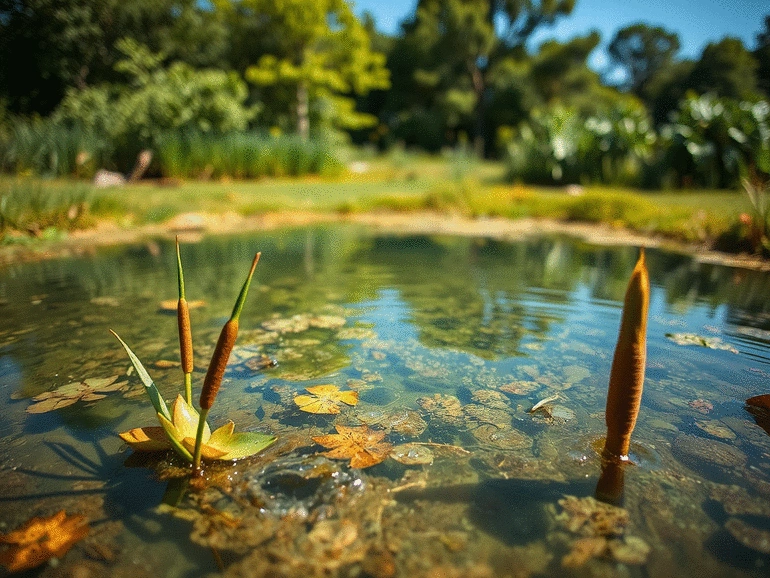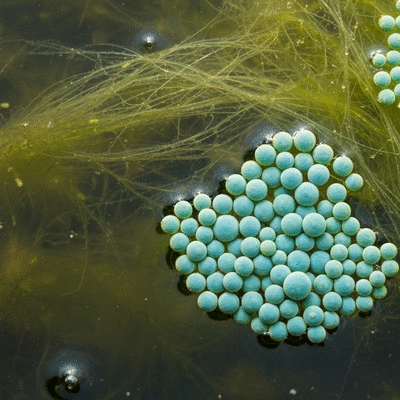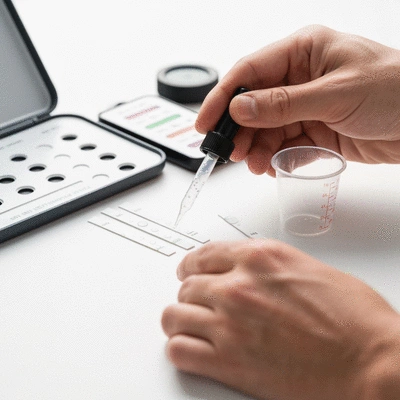Algae Growth Triggers
- Nutrient Overload
- Sunlight Exposure
- Water Temperature

Effective pond maintenance begins with understanding the delicate balance within your ecosystem. Are you aware of the role algae plays and how to manage it for optimal pond health? This guide will equip you with the insights needed for successful pond care!
This visual outlines the key factors contributing to algae growth, the different types of algae, and effective solutions for maintaining a healthy pond ecosystem.
Identifying algae helps in effective management.
Eco-friendly ways to manage algae growth.
As a pond care enthusiast, I've seen firsthand how algae plays a complex role in small pond ecosystems. While some algae are natural and can even be beneficial, excessive growth can lead to a host of problems. In this section, I’ll explore the different types of algae and how they affect your pond's health, so you can make informed decisions for maintenance!
Understanding the role of algae is essential for anyone who wants to maintain a healthy pond. The balance of algae can be delicate, and knowing what triggers their growth can help you take proactive steps to keep your pond thriving.
To effectively manage algae, it's crucial to recognize the main types that may inhabit your pond. Here are two common varieties:
Each type of algae has its own characteristics and growth patterns, so identifying them correctly can make a huge difference in your algae management efforts. While filamentous algae may simply require regular maintenance, blue-green algae can pose risks to aquatic life.

When it comes to identifying algae, color and texture are key indicators. Filamentous algae tend to cling to surfaces, creating a fluffy appearance, while blue-green algae can appear more like paint floating on the water surface. If you notice a sudden bloom of blue-green algae, it's time to take action!
Using a simple water quality test kit can also help you monitor the health of your pond. Testing for pH, ammonia, and nutrient levels provides valuable insights into what might be fueling algae growth.
It's essential to know what causes algae to flourish in your pond. Key factors include:
By understanding these triggers, you can take steps to minimize their impact on your pond. For instance, consider planting trees or shrubs that provide shade to reduce sunlight exposure!
Eutrophication is a process where a water body becomes overly enriched with nutrients, leading to excessive algae growth. This can result in a decrease in water quality and negatively affect aquatic life. Recognizing signs of this process is vital for anyone managing a small pond. To understand more about nutrient sources and their impact, consult this resource on nutrient management in ponds from Texas A&M.
Increased algae blooms can lead to oxygen depletion in the water, which is harmful to fish and other aquatic organisms. Being vigilant about your pond's nutrient levels can help prevent eutrophication from spiraling out of control.
There are several indicators that your pond may be experiencing nutrient overload:
If you notice any of these signs, it might be time to reassess your pond management strategies! With the right interventions, you can restore balance to your pond and ensure it remains a vibrant ecosystem for years to come.
What do you think about the impact of algae on your pond? Share your thoughts below:
When it comes to maintaining a healthy pond ecosystem, long-term monitoring is essential. Just like any living environment, ponds require regular attention to stay balanced and thriving. This means establishing routines to assess the water quality, fish health, and plant vitality consistently. By staying proactive, you'll catch any issues before they escalate, ensuring your pond remains a beautiful and serene feature of your landscape!
A successful pond management strategy hinges on a few key maintenance practices. Here are some tips to incorporate into your routine:
By following these tips, you'll create a solid foundation for your pond's health. Remember, monitoring isn't just about fixing problems—it's also about celebrating the successes along the way!

Creating a consistent assessment routine can make a world of difference in how your pond evolves. I recommend setting specific days each month to check on your pond's health. During these assessments, look for:
This kind of routine allows you to track your pond's journey and make informed decisions about any necessary adjustments. It’s all part of giving your pond the care it deserves!
Effective algae management can transform your pond into a vibrant ecosystem that supports a variety of life. But how do you know when you're making progress? Here are some indicators of success:
Tracking these outcomes helps you celebrate small victories while guiding ongoing strategies. Are you ready to see how these changes impact your pond over time?
Monitoring your pond’s health involves more than just looking for problems. Keeping a detailed log of your observations can help you adjust your strategies effectively. Consider these methods:
With careful tracking, you'll be well on your way to managing a healthy pond ecosystem that you can enjoy year-round!
One of the most effective and eco-friendly ways to manage algae is through fish stocking. Certain fish species can help control algae levels while enhancing your pond's beauty and vitality. Here are a few species that I recommend:
By choosing the right fish, you can create a balanced ecosystem that reduces algae naturally. Plus, watching them thrive brings joy to any pond owner!
When selecting fish for your pond, consider the following factors to ensure compatibility:
Taking the time to choose appropriate fish not only helps with algae control but also enriches your pond experience!
As a pond care expert, I believe that finding the right strategies for your pond is crucial. Remember, every pond is unique, and what works for one may not work for another. Keep experimenting with different approaches to discover what suits your specific needs best!
A decision tree can help simplify the choices you have to make regarding pond maintenance. Start by evaluating your pond's current state, then consider:
By mapping out your options, you'll gain clarity on how to proceed effectively. It’s all about finding the right path for your pond!
Maintaining a healthy pond ecosystem is a journey that requires a balance of immediate fixes and preventive measures. While it's tempting to rely on quick solutions, sustainable management practices will yield long-term benefits. You’ll not only create a thriving environment for fish and plants but also enjoy the peaceful beauty of your pond.
Ultimately, an effective algae management strategy combines quick fixes with long-term solutions. Here are some strategies to consider:
By embracing both approaches, you can enjoy a healthier pond that remains beautiful and inviting for years to come. Are you ready to dive into your pond care journey?
Here is a quick recap of the important points discussed in the article:
At Clear Pond Solutions, we empower you with expert guidance and eco-friendly solutions to create and maintain pristine, healthy pond ecosystems. Your thriving pond is our priority.
